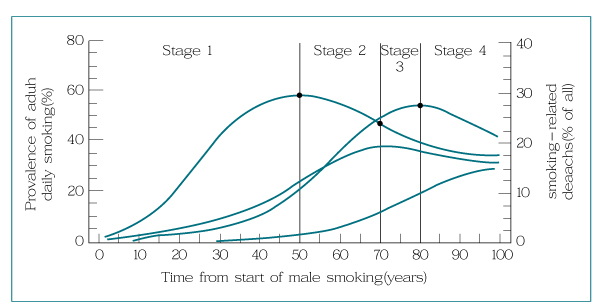J Korean Med Assoc.
2004 Jun;47(6):545-555. 10.5124/jkma.2004.47.6.545.
Anti-smoking Education by Medical Doctor
- Affiliations
-
- 1Department of Family Medicine, Keimyung University School of Medicine, Dongsan Medical Center, Korea. dhkim@dsmc.or.kr
- KMID: 2065238
- DOI: http://doi.org/10.5124/jkma.2004.47.6.545
Abstract
- Medical doctors are an important role model for smoking behavior, and their advice to quit smoking is effective for patients. Doctors can be teachers and educators for social anti-smoking activities in their communities. Schools, social organizations, hospitals, and local and national government officials can be interested in providing anti-smoking programs. Well-preparedness is important for an effective delivery of anti-smoking messages. To ensure the success of presentation, the organizers should consider the followings: (1) determine the objectives before planning the presentation; (2) analyze the values and needs of the audience; (3) determine the best presentation method; (4) make the presentation interactive through questions and answers or activities (5) select slides and other visual aids carefully; (6) incorporate introduction and conclusion to the main ideas; and (7) prepare answers to anticipated questions. Colors and layouts should be considered in preparing and showing visual aids. For those deliver presentation, repeated rehearsals will make them more relaxed and at ease, which is also important for successful presentation. Each presentation will be different because the needs and receptivity of the audience will be different in each occasion. Give the audience a clear idea of what your goals of the presentation are. Let them know first what materials including handouts will be distributed, lest they should distract their attention taking unnecessary notes. Establish a firm rapport and give information. Remember that there may be smokers; don't insult or degrade them. Acknowledge the challenges in smoking cessation and make a caring, non-hostile tone towards smokers.
MeSH Terms
Figure
Reference
-
1. Mackay J. American College of Chest Physicians. Task Force on Women & Girls, Tobacco, & Lung Cancer. CHEST Foundation. Don't let the lives of women and girls go up in smoke (Speakers Kit, Asian edition). 2004.2. Richmond RL. Physicians can make a difference with smokers: evidence-based clinical approaches. Int J Tuberc Lung Dis. 1999. 3:100–112.3. Mackay , Eriksen Michael. The Tobacco Atlas. 2002. Geneva: Judith World Health Organization.4. Ramstrom LM. Bollijer CT, Fagerstrom K, editors. The tobacco epidemic. Prog Respir Res. 1997. 27:6.5. The Global. The Global Youth Tobacco Survey Collaborative Group. Tobacco use among youth: a cross country comparison. Tobacco Control. 2002. 11:252–270.
Article6. Ezzati M, Lopez A. Burden of disease attributable to smoking and oral tobacco use. Global and Regional estimates for 2000. To appear in Comparative Risk Assessment. 2002. Oxford University Text.7. Jha P, Chaloupka FJ. Tobacco control in developing countries. 2000. England: Oxford University Press;239–240. 4218. Curbing the Epidemic : Governments and the Economics of Tobacco Control. 1999. Washington: World Bank.9. Leistikow BN, Martin DC, Milano CE. Fire injuries, disasters, and costs from cigarettes and cigarette lights: A global overview. Preventive Medicine. 2000. 31:2–91. –99.
Article10. Halpern MT, Shikiar R, Rentz AM, Khan ZM. Impact of smoking status on workplace absenteeism and productivity. Tob Control. 2001. 10:233–238.
Article11. Guindon GE, S Tobin S, Yach D. Trends and affordability of cigarette prices: ample room for tax increases and related health gains. Tobacco Control. 2002. 11:35–43.
Article12. Agency for Health Care Policy and Research. Centers for Disease Control and Prevention. Smoking Cessation : Clinical Practice Guideline Number 18. 1996. 04.13. US Department of Health and Human Services. The health consequences of using smokeless tobacco. A report of the advisory committee to the Surgeon General. 2001. Bethesda, Maryland: Public Health Service, National Institutes of Health.
- Full Text Links
- Actions
-
Cited
- CITED
-
- Close
- Share
- Similar articles
-
- The Smoking Rate Among Doctors and Its Various Implications
- Compare the Knowledge, Attitude and Behavior about Smoking in the Elementary Students according to Anti-smoking Education
- Smoking Prevention and Anti-Smoking Education in School
- A Study on Adolescents' Smoking Behavior and the Status and Need of Smoking Prevention Education for Adolescents
- Global Doctor's Role and Outcome-Based Medical Education


